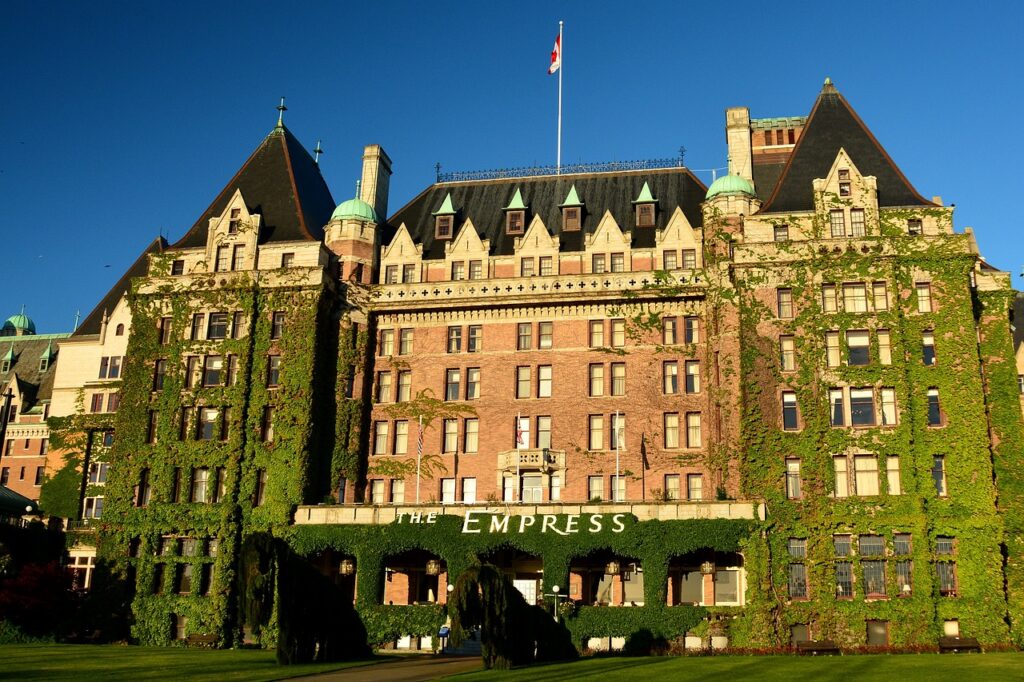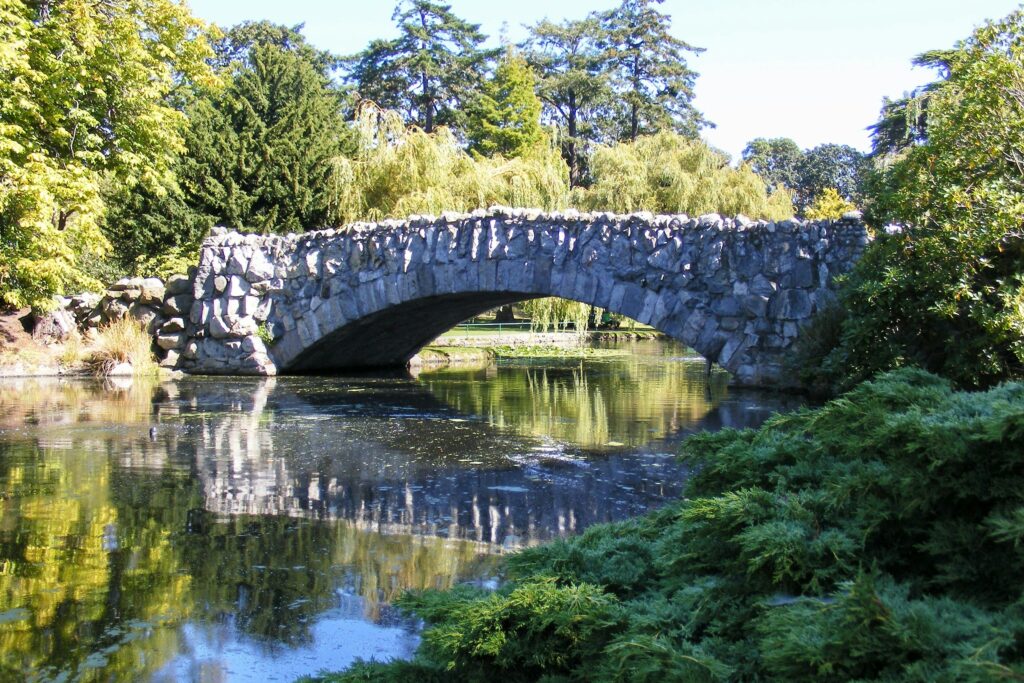While the sun is shining, one of the best things to do in a city like Victoria is walk! While it is a relatively young city, there are quite a few heritage sites in Victoria BC that offer a fascinating peek into the past. Many of these sites are located downtown, with a few located just outside the downtown centre. So if you’re staying downtown Victoria, you can step out your door at any time to begin your heritage tour! But no matter where you’re staying, whether you’re on the water in Sooke or Sidney, or enjoying a countryside getaway in the Cowichan Valley, these sites are worth the drive into Victoria!
Downtown
Parliament Buildings
Located in the beautiful Inner Harbour, the Parliament Buildings might be one of the most recognized landmarks in Victoria since they were built for Queen Victoria’s Diamond Jubilee in 1897. Built by a young and exuberant architect from England, Francis Rattenbury designed the building to create a sense of importance and provide the burgeoning city with a seat of Parliament as it sought to join Canada. Rattenbury’s impressive building is also a testament to the raw materials found on the island and how new, foreign material can be used to create a building that is as impressive and opulent as the Parliament Buildings. While the exterior is grand and impressive with its domed oxidized copper roofs, a grand facade and stately grounds, the interior is equally magnificent. With each stately room adorned with filigree, gold leaf, murals stained glass, important artifacts, columns throughout and the magnificent rotunda, you can see how this building was and still is, such an important part of Victoria’s identity. You can go on a free guided tour to learn more about building and even watch the action when the legislature is in session!
Empress Hotel
Not unlike how Haussmann changed the face of Paris under Napoleon, Francis Rattenbury was an instrumental part of defining Victoria architecture and creating the city’s identity. Not long after the construction of the Parliament Buildings was completed, Rattenbury was again commissioned to create a hotel that would be suitable to entice the wealthy Canadians during the gold rush of BC to come from the eastern Provinces of Canada as a part of the Canadian Railway project. In 1908 The Empress Hotel was constructed and today still stands as a functioning hotel and a stunning piece of architectural history. The enormous chateau-style building that sits adjacent to the Parliament Buildings in Victoria’s Inner Harbour, looks out over the water and encompasses an entire city block. Over the years, The Empress has undergone an incredible amount of changes, upgrades and expansions and while one would think that this would detract from the heritage qualities of the building, the most recent renovation has spared no expense in bringing her back to her full beauty while exquisitely maintaining all the features that make The Empress a truly Victorian, heritage landmark.
St. Ann’s Academy
Just behind The Empress, set back from the hustle and bustle of the Inner Harbour and on the corner of the exquisite Beacon Hill Park you’ll find St. Anne’s Academy. Constructed in 1858, St Anne’s was the first Roman Catholic Church in Victoria at the time and offered a place for the Catholic community of Victoria a place of worship. By 1910, the building was truly completed and was a Catholic Girl’s school until its closure in 1974. At that time it had fallen into total disrepair and had to be condemned and boarded up. However, a municipal restoration project acquired funds to work on repairing the buildings and grounds of St. Anne’s and today, guests can visit these restored heritage sites. The chapel, adorned with stained glass, a beautiful altar and a pipe organ from 1913 is a glimpse into Victoria’s beginnings and on a sunny afternoon, St. Anne’s gardens are lovely to wander through. Spending a peaceful afternoon in the gardens of St. Anne’s is the perfect activity for a sunny day where you can explore the formal garden, the summer house alive with perennials and a lush herb garden.
Chinatown
In 1858, gold was discovered in the Fraser Canyon. Word spread like wildfire and a sudden surge of immigration to BC began. Many of the newcomers were from California, the site of an early gold rush, and approximately one third of these newcomers were Chinese. Within only a year, word about the gold in BC had made it across the Pacific Ocean to China where many decided to leave their country to seek fortune in BC. Not only was it the gold that prompted this emigration but also war, famine and drought in many parts of China made the dangerous journey across the Pacific to a strange, new land an attractive prospect. Victoria’s Chinatown was initially just a collection of crude wooden huts at the edge of a trading post-turned-burgeoning city but it evolved into an area that was densely populated with thriving businesses, theatres, schools, temples and a hospital. Despite this, Chinatown gained a dark reputation mainly because of the opium factories, gambling dens and brothels in the area. In the late 1800s and early 1900s Chinatown grew rapidly until its peak in 1911 when it occupied six city blocks at the north end of downtown. Today, Chinatown occupies the 500 to 600 block of Fisgard St. in downtown Victoria. It’s a popular destination for locals and visitors, a National Historic Site and famed for the incredible food, shopping and beautiful Gate of Harmonious Interest. While Chinatown in 2022 is small, there is no quantifiable measure to express the immense impact and importance the Chinese community has had in the growth, success and diversity of Victoria as a city.
Emily Carr House
Whether you’re familiar with the work of Emily Carr or not, this heritage site is worth a visit! Tucked away in the beautiful neighbourhood of James Bay, on a quiet street, is the childhood home of Emily Carr. Known best for her abstracted paintings of the BC wilderness, Carr spent her life painting, writing about and appreciating her home on the West Coast. With her unique painting style, her appreciation for and affinity with the First Nations people of BC, and straightforward writing style, Emily Carr remains an important artist in Canadian history. For her time, Carr was an anomaly: an unmarried woman who was insistent on living life on her own terms. She spent many years travelling alone to both Europe to learn to paint and meet with other artists and to remote parts of BC to live with different First Nations groups, drawing, painting and writing about what she saw. In addition to the visual arts, Carr was also an author and wrote many books, most notably, her novel Klee Wyck which won the Governor General’s Gold Medal for Literature. While Carr’s work is ubiquitous in the galleries and museums around BC, the Carr house provides something different. It allows visitors to interact with this interpretive display of Carr’s life, work, passions and legacy.
Government Street
As one of the oldest streets in Victoria, Government Street is a fascinating street to walk down for the history and architecture, but it is also one of the best places to shop and dine as well! While you’re walking up this street, there are a few places that are a must to pop in!
- Murchies: Since 1894, Murchies has been blending perfectly balanced teas, providing Victorians and visitors alike with unique drinks, delicious food and a gorgeous place to enjoy both! The architectural details of the interior really showcase the original Art Deco design of the building and provide patrons an experience from another time.
- Rogers Chocolates: In the late 1880’s Charles Rogers moved to Victoria and soon after, opened a green-grocer to support his growing family. Not long after opening his shop however, he noticed that the chocolates that he was ordering from San Francisco were constantly selling out. They were simple chocolates and Charles decided that rather than a green-grocer, he wanted to make chocolates – right there in his shop! Since then, Rogers chocolates has been a staple in the merchant community in Victoria and today, they still make incredible chocolates.
- Bastion Square: For all intents and purposes, one could say that Victoria began in Bastion Square. In 1843, the Hudson Bay Trading Company established a trading post on the site of present day Bastion Square. After Victoria had grown, Bastion Square became the site of public hangings, the prison and the courthouse. Later and as it stands today, Bastion Square is the site of incredible restaurants, the Maritime Museum and where markets are held, public art is displayed and a bustling part of downtown Victoria.
Helmcken House
Officially the oldest house in Victoria, Helmcken House looks out of place on the concrete courtyard section of Thunderbird Park outside the Royal BC Museum. Helmcken House is not just the oldest house in Victoria, but was also the home of the famed Doctor Helmcken, a figure who was instrumental in Victoria’s growth. Originally a prominent employee of the Hudson Bay Company, Helmcken was a highly respected medical professional, the founder of the British Columbia Medical Association and one of the three negotiators that manoeuvred BC to becoming an official province of Canada. As a visitor, you can tour the house and see how life for people in 1920 Victoria was as well as getting a glimpse into the medical bag of a 19th century doctor!
Outside of Downtown
Hatley Castle
Built in 1908 by James Dunsmuir, the son of the incredibly wealthy coal baron Robert Dunsmuir, this grand fortress-like building was an enormous undertaking. The stunning gardens weren’t built until 1912 when the Dunsmuirs hired a landscaping company out of Boston to design the entire estate. Their landscape designer created three ‘garden rooms’ – a popular style of the time – the Japanese, Italian and Rose gardens. Today, the grounds stand as a testament to the opulence and order of Edwardian garden design. Hatley Castle was James’ home until his death in 1920 and would stay in the Dunsmuir family until 1937 when James’ wife and daughter died. After that time, it stayed in the care of their caretaker for three years before it was purchased by the government and was a Naval training base. It then became a military college and is now the administrative offices of Royal Roads University. It has been used as the backdrop for many TV shows and movies and is an incredibly popular site for visitors and locals to visit. You can opt for a self guided tour and walk the expansive Edwardian-style gardens and grounds,
Craigdarroch Castle
Built by local coal baron, Rober Dunsmuir in the 1800s, Craigdarroch Castle is a beautiful heritage site nestled in the lovely neighbourhood of Rockland. Built for entertaining and impressing their peers, when the Dunsmuirs lived there, there was seldom a weekend when there wasn’t a gathering of all of Victoria’s wealthiest families. And it is certainly impressive! With endless dark wood and intricate carvings, the spiral staircase to the turret, grand living spaces and beautiful grounds, it is clear that Robert was determined to recreate a European-style castle in Victoria. Today, thousands of people visit each year to marvel at this stunning modern-era castle that boasts 39 beautifully preserved rooms, stately staircases and soaring turrets. Take a wander at your own pace on a self guided tour and be transported to another time.
Fisgard Lighthouse
Built in 1860, the Fisgard Lighthouse, positioned on the entrance of Esquimalt Harbour was originally a beacon to guide the British Royal Navy’s Pacific Squadron as they came into Victoria. In 1929, the beacon was automated but for sixty nine years a lighthouse keeper was stationed at Fisgard Lighthouse to ensure the beacon functioned and kept vessels safe. Today, visitors can see artefacts from the history of the lighthouse including displays detailing the life of a lighthouse keeper, the west coast storms and ships lost at sea. Additionally, this is a stunning location to watch the sunset, get a glimpse of our marine life and watch the sailboats drift through the water on a warm summer evening.





